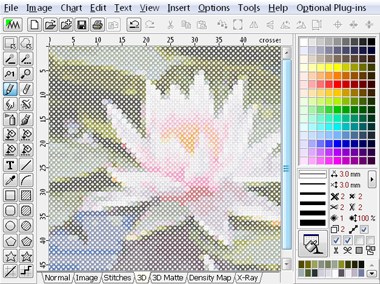Software For Cross Stitch
In this quarters XStitch Magazine I wrote about the Silk Road, and how an often ignored part of Asian history had a vital impact on the origins of cross stitch.
In the peice I often talk about silk, hence the Silk Road name, and talk about how it threads migrated along the route, eventually ending in the round city of Baghdad, where cross stitch was invented. Here not only did they invent the stitch itself, but hessian, an early form of aida. You can find out more in our definitive history of cross stitch. However, my XStitch piece ends there, with silk fibers on a hessian back. So how come we now stitch using cotton fibers?
- Software For Creating Cross Stitch Patterns
- Software For Cross-stitch Pattern Maker
- Free Software For Cross-stitch Patterns
- Pattern Maker Software For Cross-stitch
Cross Stitch Professional Platinum This software is used for creating unique custom cross stitch charts. Another function it offers is transforming digital photographs into charts. It creates complete ones that don’t require any additional editing. Create customized cross-stitch patterns with this software, but it may be too complex if you're a novice user. Cross Stitch Professional offers a multitude of buttons and controls to add stitches. A free and open source program for creating cross stitch patterns from images Home Example Doc Download Source Screenshot of cstitch, showing the original image on the left and an edited squared version on the right - the original image uses 68,439 colors, the one on the right uses 23.
So why did we change from silk to cotton threads?

It should be noted that whilst cotton has always been used as a threads, it was a luxury product. Silk, was the cheaper alternative. The reason for this was simple, whilst there was more cotton avaliable, the processing of cotton took a very long time. Unlike silk strands; literally taken from silk worm cocoons in a long strand, cotton had to be cleaned, split, pulled, standed, woven and washed again. This took a long time, and meant that cotton production wasn’t a viable alternative to silk production.
Software For Creating Cross Stitch Patterns

Software For Cross-stitch Pattern Maker
But things did start to change. In India in the 5th century they invented a rolling cotton gin. This allowed them to clean and split the cotton fibers very quickly. It was reported that one man and one woman, without using a cotton gin could clean half a pound of cotton a day, but with the cotton gin, they could clean 28 pounds, and if an oxen was put to work, they could make 750 pounds a day. They soon started production large scale and cotton became a rewarding, but niche industry. The reason it was so niche was thanks to India’s specific climate. The climate allowed for gorwth of long-staple cotton, which, apart from a few other locations, only grew in India.
Free Software For Cross-stitch Patterns
Therefore, whilst India enjoyed the advances of cotton, much of the world went without. That was, until 1793, and Eli Whitney.
Who’s Eli Whitney?
Pattern Maker Software For Cross-stitch
Eli Whitney, to most, is known as one of the many key figures in starting the American Civil War. This is all due to slavery. When America got its independance in 1776, slavery was a trade, but not a booming one. Slaves had their uses, but in most instances their cost outweighed their use. By the mid 1700s, rice, tobacco, and indigo were all losing value, and slavery started to dwindle. This is where Eli’s new cotton gin comes in. Eli, who was against slave ownership, wanted to invest in the future of the United States and created a tool that could be used with the US short-staple cotton, much in the same way India had used it, with livestock.
Whilst this was a noble pursuit, it turned out that the new cotton grew fantastically well in Georgia state. Slavery not only became profitable, but took the US by storm, in part resulting in the start of the American Civil war. Eli actually worked with the North to abolish slavery, however his invention, the cotton gin, was a tool that revolutionised the fabric trade.
Soon, the cotton gin was exported all over the world, where it became the most cost effective tool for making thread.